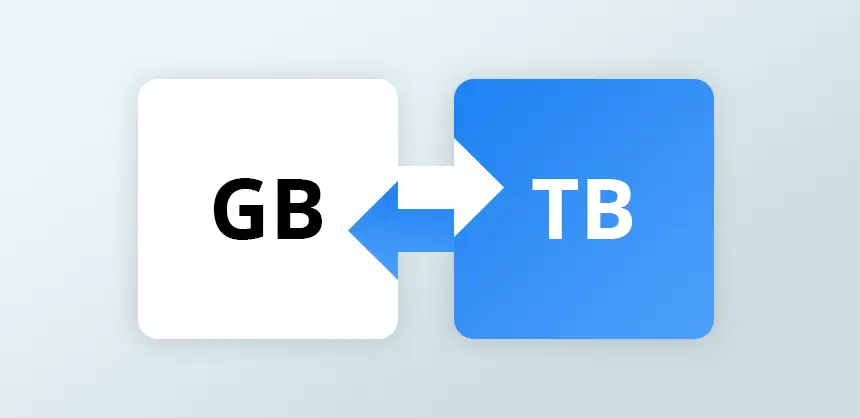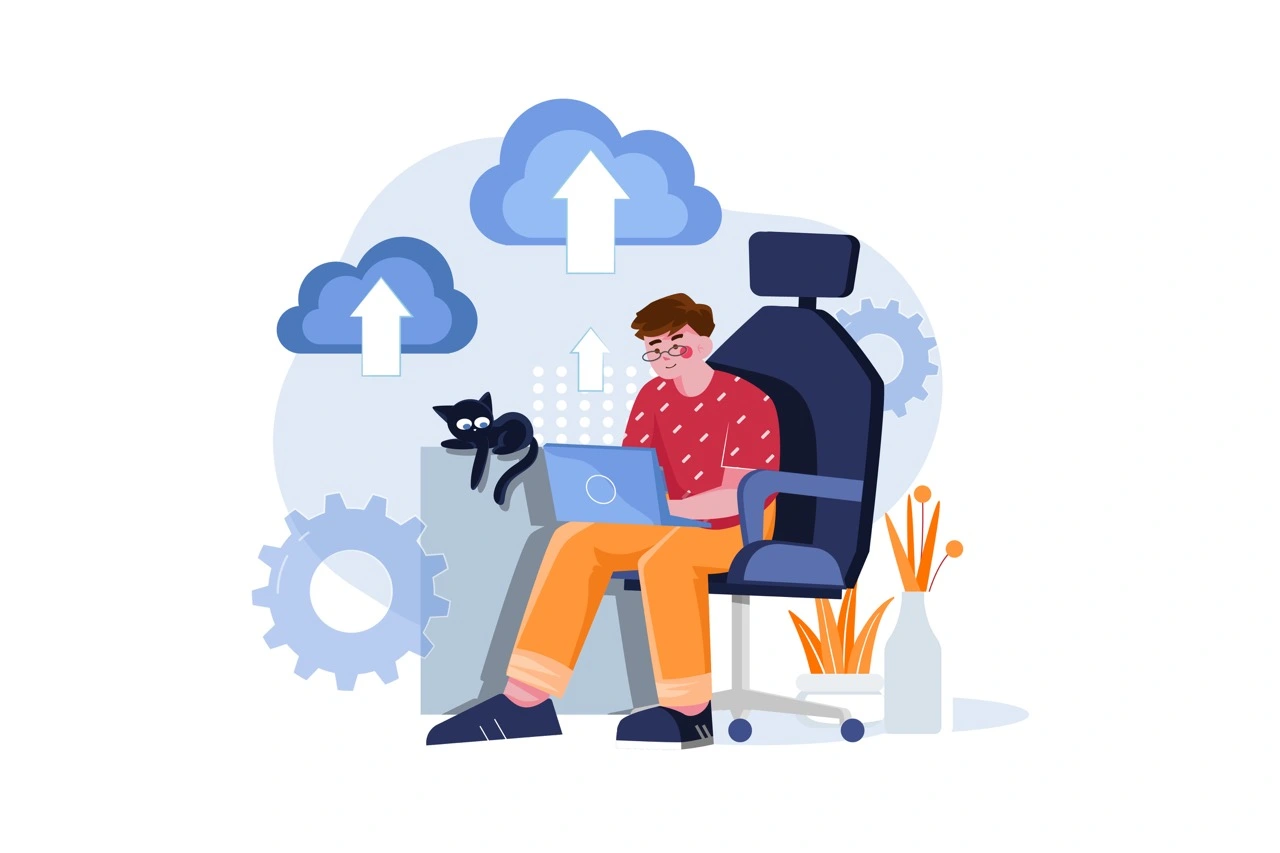How many GB in a TB? Quick guide
Today's world is full of data, making it important to understand digital storage sizes. Whether you're into technology, work in business, or just trying to pick the right storage, knowing the gigabytes in a terabyte matters. This knowledge helps make better choices.
One gigabyte, or GB, equals 1 billion bytes in decimal, or about 1.07 billion bytes in binary. On the other hand, a terabyte (TB) is roughly 1 trillion bytes or more exactly, 1.09 trillion bytes, in binary form. There are 1024 GB in a TBwhen we talk binary, and 1000 GB in a TB in decimal terms. Knowing this difference is crucial for correctly figuring out storage needs for people and businesses.

Key Takeaways
- A gigabyte consists of 1,000,000,000 bytes in decimal form or 1,073,741,824 bytes in binary form.
- A terabyte is equal to about 1 trillion bytes in decimal or 1,099,511,627,776 bytes in binary.
- The conversion metric for storage: 1024 GB = 1 TB in binary, 1000 GB = 1 TB in decimal.
- Gigabytes are often used for everyday devices, while terabytes cater to large-scale data storage needs.
- Real-world examples include smartphone storage (GB) and external hard drives (TB).
Introduction to Data Service Units
In the world of computing and storage, knowing data measurement units is key. Bytes, kilobytes, megabytes, gigabytes, and terabytes are measures of data. Understanding them helps us use technology better.
Defining Bytes and Their Hierarchy
A byte is the basic building block for storing data, holding 8 bits. It usually stores a letter or a number. Moving up, 1 kilobyte (KB) has 1,024 bytes, 1 megabyte (MB) has 1,048,576 bytes. 1 gigabyte (GB) contains 1,073,741,824 bytes, and 1 terabyte (TB) holds 1,099,511,627,776 bytes.
After that, 1 petabyte (PB) equals about 1,125,899,906,842,624 bytes. These measurements show how much data storage has grown. From tiny USB drives to huge enterprise data, understanding these units is vital.
Importance in Everyday Technology
Devices like smartphones and HDDs depend on these units. A terabyte can hold around 200,000 songs. Every day, the world creates over 2.5 quintillion bytes, showing our need for big storage units.
It's also about making gadgets work better. Data speeds can reach 44.2 terabits per second today. Knowing about gigabytes and terabytes is essential for getting the most from our technology.
What Is a Gigabyte?
A gigabyte (GB) is how much data your digital devices can store. It's everywhere in tech today, from phones to computers. Knowing about gigabytes helps us make smart choices with our tech.
Decimal vs. Binary Interpretations
In simple terms, a gigabyte equals 1,000,000,000 bytes in the decimal system. But, in the binary system, it's a bit more: 1,073,741,824 bytes or 230 bytes. A gigabyte also breaks down to 1,048,576 kilobytes (KB) or 1,024 megabytes (MB). This matters because tech makers and our devices count gigabytes differently. For example, what's labeled as 400 GB might show up as only 372 GB.
Common Uses of Gigabytes
Gigabytes tell us how much stuff we can keep on our gadgets. Like the iPhone 13 Pro, it can hold between 128GB to 512GB. This idea also applies to tablets, USB drives, and video game consoles. Big game files and updates need lots of GBs. Plus, apps like Netflix use plenty of gigabytes to let us watch shows without a hitch.
Examples of Gigabyte Storage
Let's look at what gigabytes mean day to day. A single DVD movie uses up about 4.7 GB. Songs from Spotify are 3 to 10 MB each. That means 1 GB can hold about 100-333 songs. Big programs, like Adobe Photoshop CS6 (32 bit), need 1 GB just to get installed. These examples show how crucial gigabytes are for keeping our digital world running smoothly.
What Is a Terabyte?
A terabyte (TB) is a key unit for measuring digital storage, used mainly for holding big amounts of data. We use the term terabyte to describe either 1,000 gigabytes (GB) or 1,024 gigabytes, depending on the system. The choice between the two depends on whether we're using the decimal or binary system.
Decimal vs. Binary Interpretations
The way we understand a terabyte can vary, leading to some confusion. In the decimal system, a TB equals to 1,000,000,000,000 bytes. However, in computer science, a terabyte means 1,099,511,627,776 bytes in the binary system. It's important to know these differences when talking about storage sizes and how quickly data can be moved.
Common Uses of Terabytes
Terabytes are mainly found in hard disk drives (HDDs) and solid-state drives (SSDs) with big storage spaces. For instance, some HDDs can keep up to 18 TB of data, while the largest SSDs can store up to 100 TB. They're also great for people who work with a lot of HD videos and high-quality pictures. Besides, big online servers and databases use terabytes to handle their huge information needs.
Examples of Terabyte Storage
So, what can you fit in a terabyte? You could store around 85,899,345 pages of documents or listen to 17,000 hours of music. In a household, using 1 TB every month could mean a lot of different things. It could be browsing online for over 20,000 hours, playing games for 10,000 hours, or watching 300 hours of HD video. To give you a clearer idea, look at this table with examples of data usage:
| Activity | Data Consumed |
|---|---|
| Browsing the web | 20,000 hours |
| Gaming | 10,000 hours |
| Watching HD video | 300 hours |
| Streaming 4K video | 171 hours |
The terabyte plays a big role, from personal computers to huge data centers. As tech moves forward, the need for more storage space will only increase. This highlights why it's crucial to understand and use terabytes effectively.used in com.
How Many Gigabytes in a Terabyte?
Understanding how gigabytes (GB) and terabytes (TB) connect is key for managing digital space well. One TB is 1,000 GB in simple math, but in computer language, it's 1,024 GB.
In computer science, they think of 1 gigabyte as 0.0009765625 terabytes. But, disk drive makers use simpler math, seeing 1 gigabyte as 0.001 terabytes. This difference changes how we see space on various gadgets.
When we calculate digital storage, knowing both ways to convert is important. Use 1,024 for computer math or 1,000 for simpler math, depending on what you need.
Here's a detailed view of the conversion values:
| Metric | Gigabytes (GB) | Terabytes (TB) |
|---|---|---|
| Decimal (Base 10) | 1,000,000,000 bytes | 1,000,000,000,000 bytes |
| Binary (Base 2) | 1,073,741,824 bytes | 1,099,511,627,776 bytes |
| Binary Conversion (GB to TB) | 1,024 GB | 1 TB |
| Decimal Conversion (GB to TB) | 1,000 GB | 1 TB |
Thanks to new tech, terabytes are now easier and cheaper to get. In just two years, terabyte storage costs dropped 20%. This led to a 15% increase in terabyte sales every year, showing more people want them.
Learning about these conversions helps us plan and control our digital storage better. For personal or big business use, knowing when to use computer or simple math makes managing data clear and accurate.
Real-World Applications of Gigabytes and Terabytes
Knowing how gigabytes and terabytes are used is key in today's digital world. These measurements are essential for managing and using data every day.
In Personal Devices
Gigabytes help save things like photos, music, and apps on our devices. For example, a minute of MP3 music takes about 1 MB, which means gigabytes are perfect for keeping our music. Terabytes, on the other hand, are becoming common in computers and game systems. They offer up to 1 TB of space. This is plenty for storing thousands of high-quality photos, usually 2-5 MB each.
In Data Centers
Data centers store huge amounts of data and rely on terabytes of space. They handle vast data collections that can reach up to petabytes and zettabytes. For instance, Google processed about 20 petabytes of data daily back in 2008. By 2016, the world used over one zettabyte online, and it’s expected to soar to 175 zettabytes by 2025. This shows why large storage and effective data management are crucial in these centers.
While Sharing Files Online
Services like DriveUploader have changed how we share big files online. It's important to understand gigabytes and terabytes for these tasks. Sending a high-quality video, for instance, might need several GBs. DriveUploader makes it easy by uploading large files to cloud services like Google Drive. This avoids the need for physical storage and makes sharing easier and more secure.
Why is understanding gigabytes and terabytes important for online file sharing?
For online file sharing, knowing about GBs and TBs is key. It affects how well large files transfer using services like DriveUploader.




